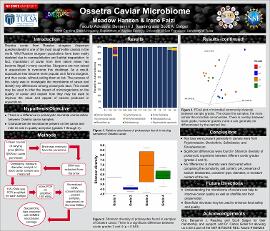| dc.contributor.advisor | Reading, Benjamin J. | |
| dc.contributor.advisor | Salger, Scott A. | |
| dc.contributor.author | Hansen, Meadow | |
| dc.contributor.author | Faizi, Irene | |
| dc.contributor.other | University of Tulsa | |
| dc.contributor.other | North Carolina State University | |
| dc.contributor.other | University of San Francisco | |
| dc.date.accessioned | 2021-09-28T01:09:23Z | |
| dc.date.available | 2021-09-28T01:09:23Z | |
| dc.date.issued | 2021-10-09 | |
| dc.identifier | oksd_OK-LSAMP_2021_hansen | |
| dc.identifier.citation | Hansen, M., Faizi, I., Reading, B. J., & Salger, S. A. (2021, October 9). Ossetra caviar microbiome. Poster session presented at the Oklahoma Louis Stokes Alliance for Minority Participation's 27th Annual Research Symposium, Stillwater, OK. | |
| dc.identifier.uri | https://hdl.handle.net/11244/330977 | |
| dc.description.abstract | Ossetra caviar from Russian sturgeon Acipenser gueldenstaedtii is one of the most sought-after caviars in the world. Wild Russian sturgeon populations have been vastly depleted in their native locations, such as the Caspian Sea, due to overexploitation and habitat degradation. In fact, the importation of caviar from their native areas has become illegal in many countries. Russian sturgeon are now raised in aquaculture to overcome this challenge. As a result, aquaculture has become more popular as it farms sturgeon, and thus caviar, without putting them at risk. The purpose of this study was to investigate the microbiome of caviar and identify key differences among prokaryotic taxa to determine whether particular organisms correspond to better flavor profiles and overall product quality. Fifteen caviars of varying prices ($60 to $595/oz.) were purchased from online vendors. Genomic DNA was extracted from the brine of each tin of caviar and prepared for sequencing. Sequences were then analyzed using the QIIME 2 microbiome bioinformatics platform. A diverse array of microorganisms were found to be present across all caviar samples. Although no differences in diversity were discovered when comparing the grade, osmolarity, salt content, pH, presence of sodium tetraborate (chemical preservative), container type, or diameter or moisture content of the roe, there were differences in the microbial composition of the caviars. This model may be used to infer the impact of microorganisms on the quality of caviar and explain how they may be used to improve the value and appeal of caviars produced in aquaculture. | |
| dc.description.sponsorship | Oklahoma Louis Stokes Alliance for Minority Participation Program | |
| dc.description.sponsorship | National Science Foundation (U.S.). Biotechnology-based Sequencing-based Undergraduate Research Experience (BIT SURE) | |
| dc.format | application/pdf | |
| dc.language | en_US | |
| dc.publisher | Oklahoma State University | |
| dc.rights | In the Oklahoma State University Library's institutional repository this paper is made available through the open access principles and the terms of agreement/consent between the author(s) and the publisher. The permission policy on the use, reproduction or distribution of the article falls under fair use for educational, scholarship, and research purposes. Contact Digital Resources and Discovery Services at lib-dls@okstate.edu or 405-744-9161 for further information. | |
| dc.title | Ossetra caviar microbiome | |
| osu.filename | oksd_OK-LSAMP_2021_hansen.pdf | |
| dc.description.department | Applied Ecology | |
| dc.type.genre | Poster | |
| dc.type.material | Text | |
| dc.subject.keywords | caviar | |
| dc.subject.keywords | applied ecology | |
| dc.subject.keywords | ossetra | |
| dc.subject.keywords | microbiology | |
